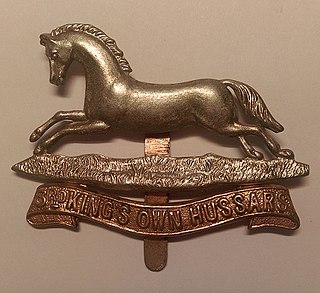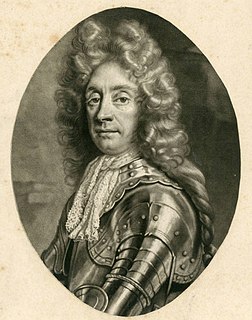Related Research Articles

The Battle of the Boyne was a battle in 1690 between the forces of the deposed King James II of England and Ireland, VII of Scotland, versus those of King William III who, with his wife Queen Mary II, had acceded to the Crowns of England and Scotland in 1689. The battle took place across the River Boyne close to the town of Drogheda in the Kingdom of Ireland, modern-day Republic of Ireland, and resulted in a victory for William. This turned the tide in James's failed attempt to regain the British crown and ultimately aided in ensuring the continued Protestant ascendancy in Ireland.

The Treaty of Limerick, signed on 3 October 1691, ended the 1689 to 1691 Williamite War in Ireland, a conflict related to the 1688 to 1697 Nine Years' War. It consisted of two separate agreements, one with military terms of surrender, signed by commanders of a French expeditionary force and Irish Jacobites loyal to the exiled James II. Baron de Ginkell, leader of government forces in Ireland, signed on behalf of William III and his wife Mary II. It allowed Jacobite units to be transported to France, the diaspora known as the Flight of the Wild Geese.

The Williamite War in Ireland (1688–1691), was a conflict between Jacobite supporters of deposed monarch James II and Williamite supporters of his successor, William III. It is also called the Jacobite War in Ireland or the Williamite–Jacobite War in Ireland.

The Battle of Aughrim was the decisive battle of the Williamite War in Ireland. It was fought between the largely Irish Jacobite army loyal to James II and the forces of William III on 12 July 1691, near the village of Aughrim, County Galway.

Athlone was besieged twice during the Williamite War in Ireland (1689–91). The town is situated in the centre of Ireland on the River Shannon and commanded the bridge crossing the river into the Jacobite-held province of Connacht. For this reason, it was of key strategic importance.

Limerick, a city in western Ireland, was besieged twice in the Williamite War in Ireland, 1689-1691. On the first of these occasions, in August to September 1690, its Jacobite defenders retreated to the city after their defeat at the Battle of the Boyne. The Williamites, under William III, tried to take Limerick by storm, but were driven off and had to retire into their winter quarters.
The Break of Dromore took place on 14 March 1689 near Dromore, County Down in the early stages of the Williamite War in Ireland. It featured Catholic Jacobite troops under Richard Hamilton and Protestant Williamite militia led by Hugh Montgomery and Arthur Rawdon.

The 3rd Hussars was a cavalry regiment of the British Army, first raised in 1685. It saw service for three centuries, including the First World War and the Second World War, before being amalgamated with the 7th Queen's Own Hussars, to form the Queen's Own Hussars in November 1958.
John Barrett was a colonel and head of the barony of the Cork Barrett family.
The Irish Royal Army or Irish establishment refers to the British crown armies stationed in the Kingdom of Ireland between 1542 and 1801. The regiments on the establishment were placed on the British establishment following the Act of Union, although some roles continued to exist separately.
Lawrence Dempsey was an Irish soldier of the seventeenth century.

The Siege of Carrickfergus took place in August 1689 when a force of Williamite troops under Marshal Schomberg landed and laid siege to the Jacobite garrison of Carrickfergus in Ireland. After a week the Jacobites surrendered, and were allowed to march out with the honours of war.
The Raid on Newry took place in November 1689 during the Williamite War in Ireland when a Franco-Irish force loyal to James II attacked the Williamite garrison of Newry in County Down. The Raid was carried out by the French Major General Alexandre de Rainier de Droue, Marquis de Boisseleau a French officer serving with James' Irish Army. It was largely unsuccessful and the Jacobite forces withdrew having suffered casualties.
Alexandre de Rainier de Droue, Marquis de Boisseleau (1650-1698) was a French aristocrat and soldier. He is known for his service on the Jacobite side during the Williamite War in Ireland. He was one of many French soldiers sent to Ireland by Louis XIV to assist his cousin James II to keep hold of his Irish Crown. He fought alongside James' Irish Army in several military actions, most notably during the Siege of Limerick.
Mark Talbot or Marcus Talbot (c.1649-1702) was an Irish soldier and politician. He was born in Ireland and served in the French army during a time when Irish Catholics were prohibited from serving in the Irish and English armies. His father rose in prominence during the reign of the Catholic James II of Ireland, who purged Protestants from the military and replaced them with Catholics. It was in this time of upheaval that Mark Talbot became a Lieutenant Colonel in 1689. He served as a commander at Carrickfergus during a Protestant uprising against King James, and on the side of Jacobites in subsequent conflicts. For his efforts, he was promoted to Brigadier in 1691, and served as a Member of Parliament for Belfast.
The Declaration of Finglas was issued on 17 July 1690 by William III of Ireland at Finglas in County Dublin, shortly after his Williamite army's decisive victory at the Battle of the Boyne during the War of the Two Kings.
The Capture of Waterford took place in July 1690 during the Williamite War in Ireland when a force under the command of Percy Kirke captured the town of Waterford from its Jacobite Irish Army garrison. Full control of the town was not secured until Duncannon Fort across Waterford Harbour was also taken from its garrison under Michael Burke shortly afterwards. In both cases the garrisons were allowed to march out under escort to Jacobite-held Mallow in County Cork, but were denied the "honours of war" which they demanded.
William Dorrington was an English army officer. Contemporary sources often spell his surname as "Dorington", or "Dodington".
Richard Brewer was an English army officer of the seventeenth century. In 1688, Brewer took part in the Army Plot against James II during the Glorious Revolution.

Thomas Maxwell was a Scottish professional soldier.